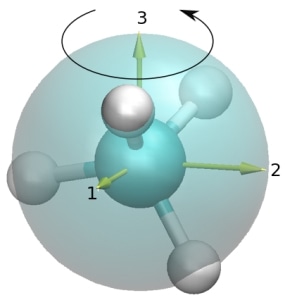Jun 18 2018
New research by Rice University chemical engineers may facilitate easier characterization of unconventional oil or gas shale formations.
 A schematic shows the rotation of methane about one of its principal axes (arrows). The rotation of the electron density (shaded sphere) generates a local magnetic field that contributes to spin-rotation relaxation, the basis for new research by Rice University researchers that refines their computer models for characterizing shale oil deposits in wells. (Illustration by Dilip Asthagiri)
A schematic shows the rotation of methane about one of its principal axes (arrows). The rotation of the electron density (shaded sphere) generates a local magnetic field that contributes to spin-rotation relaxation, the basis for new research by Rice University researchers that refines their computer models for characterizing shale oil deposits in wells. (Illustration by Dilip Asthagiri)
Nuclear magnetic resonance (NMR) tools are widely used in the oil sector to locate rich veins of methane and crude oil for extraction, mainly through hydraulic fracturing of deep shale deposits. The Rice team comprising of Professors George Hirasaki and Walter Chapman and research scientists Philip Singer and Dilip Asthagiri have enhanced their formerly reported methods to characterize methane over a broad range of densities and temperatures ranging from the liquid state to the gas state.
The scientists have tweaked their molecular dynamics models to better discriminate between molecules with either spin-spin relaxation or spin-lattice relaxation, which will enhance the ability of NMR to distinguish oil and gas from water and measure the quantity present in the rock, even in tight pore formations.
Their research paper has been published by The Journal of Chemical Physics as an open-access “editor’s pick.”
NMR tools inserted into a wellbore define the formations they see at different depths as they search for the exact spots to start horizontal drilling and fracking, which pump proppants, water, and thickening agents downhole under pressure to fracture shale and release the hydrocarbons.
The tools use the same principle that magnetic resonance imagers apply to view inside the human body: They orient and control the nuclear magnetic moments of hydrogen atoms—similar to the invisible hands of a compass - employing a combination of static and pulsed radio-frequency magnetic fields.
After the pulsed field is switched off, these moments take a few seconds to “relax” back to their initial orientations. NMR devices sense that relaxation. Since relaxation times vary based on the molecule and its environment, NMR can help identify whether a molecule is oil, gas, or water as well as collect information about the size of the pores that hold them.
“NMR relaxation times and viscosity are inversely correlated for light crude oils,” Singer said. “However, when you dissolve methane in crude oil, that correlation changes because methane has a different mode of relaxation than all the other (hydrocarbon) alkanes.
“The reason for that is because methane is a spherically symmetric molecule compared with other alkanes, which are linear, long and branched. Therefore, methane has a completely different geometry resulting in a different relaxation mode, both in bulk and in tight pores.”
Identifying that “different” mode was critical, Chapman said. “Methane mixed with hydrocarbons affects viscosity in interesting ways,” he said. “We need to understand, essentially, how much methane is in the system to relate to that response.
“What we can do in the laboratory is measure fluid properties, and we can measure NMR response,” he said. “We like to relate the two in as rigorous a theoretical approach as we can so that when we have a tool in the wellbore and it’s measuring properties of fluid in the reservoir, we can interpret those results accurately.”
The team said the interpretation of the NMR signal differs from one field—or even one well—to the next, which muddles calculations for producers characterizing a reservoir. “The kind of studies we are doing can become a bridge to interpreting those signals,” Asthagiri said.
“We hope to have a model that describes all the physics so that we don’t have to shift (the model) from one well to a different well,” Chapman added. “One size will fit all. If we can include all the physics, the model will be representative of the true physics in the reservoir.”
“Potentially we can create a library of relaxation behavior in the lab for different types of confinement, for small pores and for different chemistries of pores,” Asthagiri said. “Then we can look at a signal and read what material we are looking at downhole.”
“As we study fluids in porous media, we’re going to find that confinement changes the relaxation behavior, resulting in a different NMR response,” Chapman said. “Understanding the physics behind this response is important in characterizing the shale.”
Chapman is the William W. Akers Professor of Chemical and Biomolecular Engineering and associate dean for energy research in the George R. Brown School of Engineering. Hirasaki is the A.J. Hartsook Professor Emeritus of Chemical and Biomolecular Engineering.
The Rice University Consortium on Processes in Porous Media and the American Chemical Society Petroleum Research Fund supported the research, with computing resources supplied by the National Energy Research Scientific Computing Center, which is supported by the Office of Science of the U.S. Department of Energy, and the Texas Advanced Computing Center at the University of Texas at Austin.